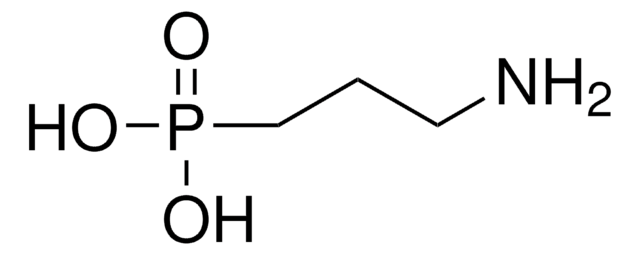Alle Fotos(2)
Wichtige Dokumente
777161
11-Hydroxyundecylphosphonic acid
≥95% (GC)
Synonym(e):
P-(11-Hydroxyundecyl)phosphonic acid
Anmeldenzur Ansicht organisationsspezifischer und vertraglich vereinbarter Preise
Alle Fotos(2)
About This Item
Empirische Formel (Hill-System):
C11H25O4P
CAS-Nummer:
Molekulargewicht:
252.29
MDL-Nummer:
UNSPSC-Code:
12352103
PubChem Substanz-ID:
NACRES:
NA.23
Empfohlene Produkte
Qualitätsniveau
Assay
≥95% (GC)
Form
powder
mp (Schmelzpunkt)
107-111 °C
SMILES String
OCCCCCCCCCCCP(O)(O)=O
InChI
1S/C11H25O4P/c12-10-8-6-4-2-1-3-5-7-9-11-16(13,14)15/h12H,1-11H2,(H2,13,14,15)
InChIKey
PPCDEFQVKBXBPS-UHFFFAOYSA-N
Allgemeine Beschreibung
11-Hydroxyundecylphosphonic acid (HUPA) is an alkyl phosphonic acid that forms a self-assembled monolayer (SAM) on a variety of metal oxides and metal surfaces. It forms a hydroxyl terminated SAM that provides a physiological stability and controls the surface density of the coating.
Anwendung
An organophosphonate surface modifier for label-free and low-cost biosensing applications;
Organophosphonic acid self-assembled monolayers (SAMs);
A hydroxyalkylphosphonate monolayer used to covalently bind primary amine groups in protein domains using chloroformate-derived crosslinking
Organophosphonic acid self-assembled monolayers (SAMs);
A hydroxyalkylphosphonate monolayer used to covalently bind primary amine groups in protein domains using chloroformate-derived crosslinking
HUPA is mainly used as a spacer/linker that forms a SAM on titanium oxide (TiO2) surfaces to immobilize the surface atoms for the formation of biocompatible materials for biomedical applications. It can also be used to functionalize the silicon-photonic resonators for biosensing applications.
Signalwort
Warning
H-Sätze
Gefahreneinstufungen
Eye Irrit. 2 - Skin Irrit. 2 - STOT SE 3
Zielorgane
Respiratory system
Lagerklassenschlüssel
11 - Combustible Solids
WGK
WGK 3
Flammpunkt (°F)
Not applicable
Flammpunkt (°C)
Not applicable
Hier finden Sie alle aktuellen Versionen:
Besitzen Sie dieses Produkt bereits?
In der Dokumentenbibliothek finden Sie die Dokumentation zu den Produkten, die Sie kürzlich erworben haben.
Kunden haben sich ebenfalls angesehen
Crystalline TiO2 grafted with poly (2-methacryloyloxyethyl phosphorylcholine) via surface-initiated atom-transfer radical polymerization
Zhao Y, et al.
Applied Surface Science, 257(5), 1596-1601 (2010)
Copper oxide surfaces modified by alkylphosphonic acids with terminal pyridyl-based ligands as a platform for supported catalysis
Andrews B, et al.
Polyhedron, 114, 360-369 (2016)
Chunyi Chiang et al.
Langmuir : the ACS journal of surfaces and colloids, 28(1), 548-556 (2011-11-23)
We report a robust strategy for conjugating mixtures of two or more protein domains to nonfouling polyurethane surfaces. In our strategy, the carbamate groups of polyurethane are reacted with zirconium alkoxide from the vapor phase to give a surface-bound oxide
Covalent functionalization of TiO2 nanotube arrays with EGF and BMP-2 for modified behavior towards mesenchymal stem cells
Bauer S, et al.
Integrative Biology : Quantitative Biosciences from Nano to Macro, 3(9), 927-936 (2011)
Phosphonic acid monolayers for binding of bioactive molecules to titanium surfaces.
Adden N
Langmuir, 22(19), 8197-8204 (2006)
Unser Team von Wissenschaftlern verfügt über Erfahrung in allen Forschungsbereichen einschließlich Life Science, Materialwissenschaften, chemischer Synthese, Chromatographie, Analytik und vielen mehr..
Setzen Sie sich mit dem technischen Dienst in Verbindung.









